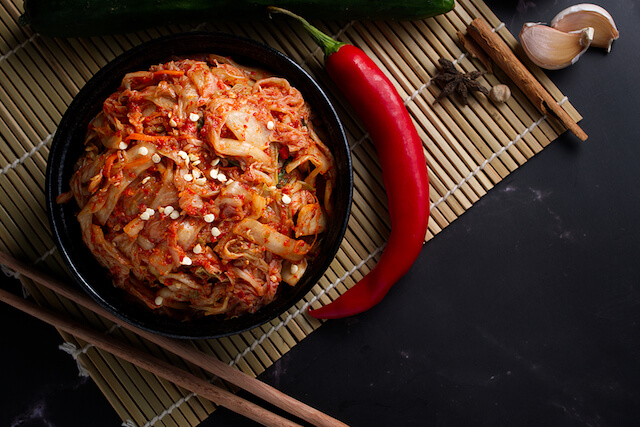Korea is a land that’s bountiful in every respect: culture, history, language, and, especially, gastronomy. As a testament to its rich cuisine, nearly every country in the world today has at least a handful of restaurants that specialise in Korean food.
Due to the massive influence of its pop culture amongst young audiences, it’s not a surprise that other aspects, such as its language and culinary offerings, would soon gain popularity as well. If you’re taking a Korean language course and are interested in knowing more about Korea, then there’s no better place to start than with Korean food. In this article, we go over the 5 Korean dishes that you must try to truly feel the Korean Spirit!
1. Kimchi (fermented vegetables)
Kimchi is one of the oldest Korean side dishes famous for being indispensable to the completeness of any Korean meal. Its origins date back to the Silla Dynasty, approximately 2000 years old. This spicy dish is made out of fermented vegetables (primarily cabbage), garlic, scallions and ginger.
Its popularity stems from its unique and delectable flavour, high nutritional value, low-calorie count, and excellent fibre content. Of course, you could swap your regular kimchi with yeolmumul kimchi if you want to try something less spicy, but regular kimchi is still a must-try!
2. Bossam (Korean Pork Lettuce Wraps)
Most South Korean meat dishes are easy and straightforward to make due to their easy preparation process and their need for only a handful of ingredients. The basic pork dish bossam is no exception. Pork, the main ingredient of this dish, is boiled in a pot of water mixed with spices such as onions, garlic, ginger, green onions, and the like until cooked tender. Afterwards, it’s then sliced into thin pieces and is ready to be served with lettuce or cabbage leaves alongside spicy dipping sauce (ssamjang) and other crunchy vegetables you may like!
3. Chuotang (Mudfish Soup)
Like most Korean foods, chuotang or mudfish soup also has a spicy kick to it, and its consistency is almost like a stew. The key ingredient of this soup is mudfish, or loach fish, which is crushed up and boiled so that it can’t be seen in the soup.
Along with the mudfish, its other ingredients include cabbage, garlic, soybean paste, red pepper paste, and leaks. Chuotang is a mighty healthy dish due to its high amounts of iron, protein, calcium, vitamin A, and unsaturated fats. It has an excellent combination of health benefits and a taste that will have you wanting for more, so don’t be put off by its colour the first time you try it!
4. Sundubu-jjigae (Soft Tofu Stew)
Sundubu-jjigae is an everyday spicy Korean stew typically served in a large stone bowl. Its ingredients generally consist of tofu, beef or pork, mushrooms and other vegetables, seafood, and chilli paste. This dish comes in many varieties, and depending on the chef or region, select ingredients can be either added, removed, or substituted for others. However, the tradition of adding and mixing a raw egg into the stew for additional flavour remains a staple no matter which variation you try.
5. Ganjang/Yangnyeom Gejang (Soy Sauce-Marinated Crabs)
Enjoyed by Koreans since the 17th century, gejang, which is also oft called gejeot in some regions in Korea, is a dish that consists of a variety of jeotgal (salted and fermented seafood) and is commonly served alongside a side dish of rice.
By tradition, the primary seafood used in this dish are crabs, preferably still alive. These fresh crabs are stacked into a crock and submerged with either a regular (ganjang) or chilli powder-enhanced (yangnyeom) soy sauce marinade. After a certain amount of time passes, the marinade is removed, boiled, cooled down, and then poured back into the crock, a process that is repeated numerous times and can traditionally take months to complete. Its inherently succulent and salty flavour has earned itself the label of being a “rice thief” due to its capacity to arouse your appetite so much so that you’ll forget just how many bowls of rice you’ve eaten already!
These are just a few dishes from the Korean Cuisine. Korean Cuisine is filled with different textures and surprising flavours. So give the dishes mentioned above a try, and you are sure to fall in love with Korean Cuisine.
The dishes listed in this article are only a small sample of Korean cuisine’s vast offerings of mouthwatering delights. If opportunity allows, do make time to look for restaurants near you that offer genuine Korean food and check the ones listed here if they’re on the menu. If, by chance, you’re impressed and want more, then it’s highly recommended to take a jaunt to Korea and try out the local versions themselves. To make your trip more enjoyable, enrol in a Korean language school today and make the language barrier less of a hindrance to your gastronomic endeavours!


